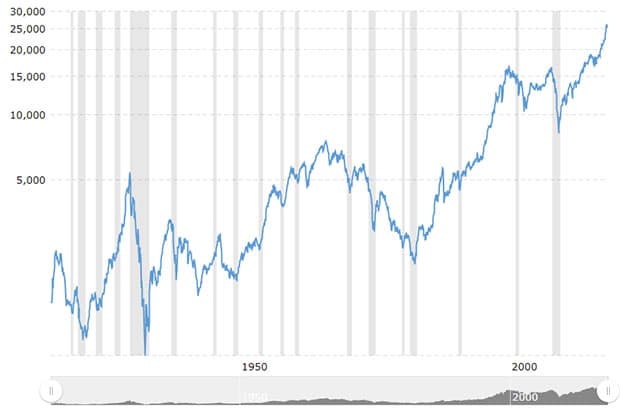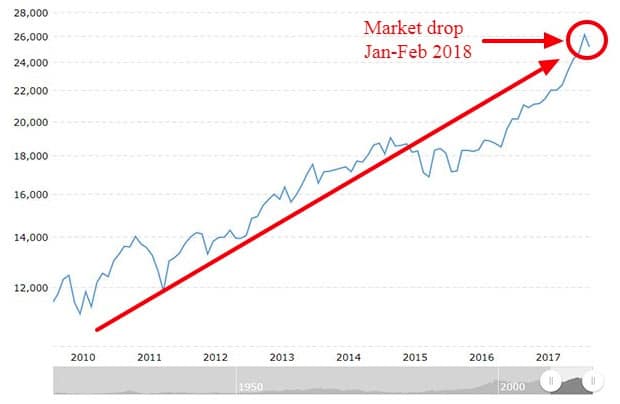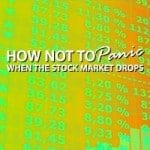This past week has been a bit of a roller coaster ride for the markets.
We’ve watched as the markets showed extreme volatility with a 1,175-point drop for the Dow Jones on Monday, February 5th, followed by a 568 point recovery on Tuesday. All this after the markets had a record breaking run of stability in 2017 into the new year – with the Dow soaring past 26,000 for the first time.
If you make your investing decisions based on what you see the markets doing on a day to day basis, you might be forgiven for being a bit stressed out this week.
As for me, I have a decidedly long term view of the markets and investing, and for me these up and down swings are just a footnote. History has shown that the markets will recover, and as long as you have time and stay the course, you’ll be just fine.
Quick Navigation
Wild Swings In The Markets
Watching the reporting on the swings up and down in the market the past week has been nothing if not entertaining.
Granted, it’s not fun to see thousands of dollars disappear from your 401(k), and when the market flies past 1000 points in it’s drop, you start to question whether it will ever stop.
Legend avers that an alert young man once found himself in the immediate presence of the late Mr. J. P. Morgan. Seeking to improve the golden moment, he ventured to inquire Mr. Morgan’s opinion as to the future course of the stock market. The alleged reply has become classic: “Young man, I believe the market is going to fluctuate.”
If you step back, however, and look at the long term record of the markets, you know that these types of ups and downs will happen. If you take a long term view, you start to realize that it might be a good time to buy, with stocks at a discount!
Taking A Long Term View Of The Markets
Looking back 100 years at the Dow Jones Industrial Average, you start to see a trend. Over time, the DJIA and stocks in general tend to increase in value.
Yes, there are blips along the way, and even some precipitous drops into some deep canyons (see the vertical gray bands above – where recessions hit), but over time things do recover, and even continue on to new highs.
Even if you look at this week’s 1000+ point drop, the largest 1-day point drop in DOW history, it’s still only a small correction in an otherwise strong market. In fact, it only returned us to the levels where the market was in mid December 2017.
The drop as a percentage of the market was about a 4% drop, and since the market is much larger than when similar point drops happened in the past, the drop is a much smaller percentage of the total market.
Do we know where the market will go from here in the next week, the next month? We can make an educated guess, but we can’t predict with certainty. The longer the time horizon, however, the better our chances of seeing significant increases over time. History is on your side.
It’s About Time In The Market, Not Market Timing
While seeing a drop in the market can be discouraging, just how discouraging it is depends on your personal situation and your outlook.
If you had only one year until retirement when the drop happened, you may be more discouraged than if you had another 30 years to invest.
Depending on your time horizon you’ll want to consider your level of acceptable risk, and figure out just how much of your portfolio you want to be in higher risk stocks, and how much you want in lower risk investments.
I would argue that you’ll want to update your asset allocation to be weighted more towards bonds and cash the closer you get to retirement to ensure that you don’t lose half your portfolio in one fell swoop.
For younger investors with a longer time horizon it’s a good idea to be more heavily weighted towards stocks, and just set it and forget it. Know that time is on your side, the longer you have until retirement, the better.
How To Invest For The Long Term: Index Funds
So what’s your best bet for seeing good returns in the long term? Investing in diversified low cost index funds, and letting it ride for the long term.
Index funds have been shown to have better returns than actively managed portfolios since they’re lower cost and have diversified their risk by investing in the entire market. Here’s what one study in the Journal of Indexes found:
An all index portfolio tends to perform better than just the sum of its parts, compared to an active portfolio. The authors created a basic 60-40 portfolio with three of the most commonly held asset classes: 40% in a broad U.S. equity fund, 20% in a broad international equity fund, and 40% in a U.S. investment-grade bond fund. They then compared this all-index portfolio to 5,000 portfolios of randomly selected, comparable actively managed funds over a 16-year period (1997 to 2012). The basic result was eye-opening, but not unexpected: The all index-fund portfolio outperformed the active ones 82.9% of the time during the 16-year period. But what really stood out was the combined performance of the index funds. When the authors examined the individual performance of each index fund in the portfolio, they all tended to outperform comparable active funds—but the result was higher when taking the three index funds together.
So when they invested in index funds, their results were higher than almost all actively managed portfolios. Plus, when they further diversified by investing in multiple index funds (like in a 3-fund portfolio), their results were even better. In other words, the odds are in your favor if you just take their advice and invest in index funds, and then diversify further across multiple index funds.
Jack Bogle, the father of index fund investing, has 8 basic rules for investing.
- Select low-cost index funds
- Consider carefully the added costs of advice
- Do not overrate past fund performance
- Use past performance to determine consistency and risk
- Beware of stars (as in, star mutual fund managers)
- Beware of asset size
- Don’t own too many funds
- Buy your fund portfolio – and hold it
So the gist of his advice is to keep your costs low, buy and hold, and make sure you stay diversified – but keep it simple.
Start Early, Keep Costs Low, Keep It Simple And Stay The Course
So what are some good ways to start investing if you want to do as Bogle suggests above? Here are a couple of ways you could get started:
Invest In A 3-Fund Portfolio With Vanguard
My first choice would just be to invest in index funds with the low cost investing leader, Vanguard. Jack Bogle is a founder of Vanguard, and they’re the industry standard when it comes to low cost index fund investing.
One of the best ways to invest with Vanguard is by buying into a three-fund portfolio. Three-fund portfolios create a simple portfolio that gives you complete coverage in the fundamental asset classes, stocks and bonds. You would buy one index fund for domestic stocks, one for international stocks and one for bonds. By way of example, here’s one such portfolio.
- Vanguard Total Stock Market Index Fund (VTSMX)
- Vanguard Total International Stock Index Fund (VGTSX)
- Vanguard Total Bond Market Fund (VBMFX)
Just how much of each you invest in is up to you and your tolerance level for risk, your time horizon for investing, etc. But typically Vanguard suggests holding anywhere from 30-40% of your allocations in international holdings. So in that case that would mean if you decide to hold 70% stocks, and 30% bond index funds, your allocations could be 50% in VTSMX, 20% in VGTSX and 30% in VBMFX.
Invest With An Automated Adviser
Another good option these days for the lazy investor is to invest with an automated investment advisor where they choose the investments for you, and regularly rebalance your assets. These are companies like Betterment, Wealthfront, Axos Invest and M1 Finance.
With these companies the investing process is dead simple. For the most part you just transfer your money in and then choose an asset allocation, stocks versus bonds. The investment advisor will then help you to invest in a diversified ETF index fund portfolio. The investments will be slightly more complicated than a 3-fund portfolio, but not exceedingly so.
Many of these companies will have an annual management fee in the range of 0.25% or so, but there are a few these days that carry no fees for their basic product. Among my favorites are:
Don ‘t Panic, Stay Invested For The Long Term
As long as you have a decent amount of time to invest, small and large market fluctuations like we’ve seen in the past week shouldn’t have too much affect on your long term plan.
At the most you may want to consider buying a bit more stock while the market is down.
As for me, I’ll be sitting back, sticking with my original plan and hoping that the market turns things around soon.
What are your thoughts on the recent instability? Will it have any affect on your plans?




Always stick with your original plan and know that long term investments will fluctuate. I just updated my investments and see a lot of red due to this market volatility. I still know that I am going to win by staying in the market and continue to invest during these dips/correction periods.
Great article, thanks for sharing Peter. I agree with you – I try to think about it as buying everything on clearance when the market really drops. Look at what we learned from the last recession regarding the differences in those who jumped off the ship and those that weathered the storm, I only hope and pray that my husband and I have the courage to put our money where our mouth is when the next one hits.